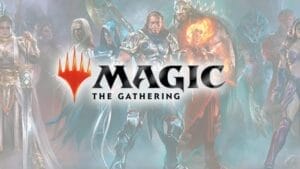
I. Introduction
In the realm of collectibles, the concept of trading platforms has seen a fascinating metamorphosis, mirroring the evolution of our society and the ever-changing preferences of consumers. Once confined to the bustling corners of physical card shops, the world of cards trading platforms now stretches across the globe, reaching out to collectors in every corner of the earth.
From the modest roots of neighborhood card shops in the mid-20th century, where sports enthusiasts would gather to swap their prized possessions, to the expansive digital markets that we navigate today, the journey of cards trading platforms is a testament to progress and adaptation. As we delve into the history of these platforms, we’ll uncover the transformative power of technology and the enduring passion of collectors.
Stay tuned as we trace the path from the shop to online, exploring how the landscape of cards trading platforms has been shaped by time, innovation, and the relentless pursuit of the perfect card.
Table of Contents
II. Physical Shops and Their Role in Cards Trading Platforms
The Genesis of Traditional Trading Card Stores
During the early days of trading card stores, collectors would gather in local shops to exchange their prized cards. These humble establishments were more than just retail outlets; they were community hubs where collectors could swap and discuss their collections, often with the ambiance of a living room or basement filled with the rich scent of old paper and plastic.
The Importance of Sports and Entertainment Cards
Sports and entertainment cards played a pivotal role in these stores, especially between the 1930s and 1950s. Icons like Babe Ruth and Lou Gehrig graced the covers of baseball cards, capturing the imagination of young fans. Meanwhile, non-sports cards, featuring characters from popular movies, comic books, and TV shows, resonated with a broader audience, expanding the reach of the collecting hobby.
The Evolution into Vibrant Community Hubs
As the trading card phenomenon grew, so did the significance of these stores. They transformed from simple places to buy and sell cards into vibrant community hubs. Collectors would not only come to buy rare editions or complete sets but also to immerse themselves in the shared passion for collecting. These stores became treasure troves of nostalgia, where customers could reminisce about the childhood memories tied to their favorite sports or characters.
By the 1960s and 1980s, trading card stores had become a staple in many communities, hosting events, tournaments, and sometimes even comic book conventions. The magic of trading cards was not just found in the individual cards themselves but in the sense of camaraderie and discovery that took place within these walls.
III. The Birth of Collectible Card Games
The Emergence of Magic: The Gathering
In the annals of collectible card game (CCG) history, Magic: The Gathering stands as a monumental leap forward. Launched in 1993, this game transcended the boundaries of simple card swapping, offering a new dimension to the hobby by integrating strategy and competition into the collection process. It was a game that required players to build decks, strategize, and engage in battles with one another, making it more than just a card collecting activity.
The Rise of Collectible Card Games as a Separate Category
The success of Magic: The Gathering catalyzed the evolution of trading cards beyond mere collectibles. It pushed the envelope by merging the thrill of collecting with the intellectual challenge of gameplay, thereby elevating the status of CCGs from a niche pastime to a full-fledged entertainment category. This pivotal moment marked a significant shift in the industry, where collecting became a gateway to competitive play.
With the advent of Magic: The Gathering, the CCG market began to diversify, moving beyond sports and entertainment cards and embracing a wide array of themes, from fantasy to science fiction, as trading cards expanded their appeal. The introduction of new games and expansions further solidified the position of CCGs as a multifaceted segment of the collectibles market, with each release bringing new opportunities for collectors and players alike.
As we reflect on the trajectory of collectible card games, it is evident that these platforms have come a long way since their inception. They have grown from humble beginnings to become a cultural phenomenon, influencing countless individuals around the world and leaving an indelible mark on pop culture. The journey of CCGs continues to unfold, with each new chapter promising fresh opportunities and innovations that will undoubtedly shape the future of cards trading platforms.
IV. The Advent of Digital Trading Cards
The Shift from Physical to Digital Formats
In the late 1990s, the internet began to change the face of many industries, including the world of card trading. The transition from physical to digital formats allowed for a more convenient and accessible means of trading cards. No longer bound by geographical location or store hours, collectors could now browse and trade cards from anywhere in the world.
Key Milestones in the Development of Online Platforms
Several key milestones marked the evolution of online trading platforms. The launch of pioneering websites like eBay and Amazon Marketplace in the late 1990s and early 2000s paved the way for dedicated card trading sites. These platforms quickly became essential tools for collectors seeking to buy, sell, and trade cards with minimal friction.
Implications for Accessibility, Affordability, and Convenience
The advent of digital trading cards had profound implications for collectors. Accessibility was greatly enhanced, as collectors no longer needed to travel to specific locations to find rare cards or meet other collectors. Affordability saw improvements too, as online platforms allowed for transparent pricing and competitive bidding, reducing the cost of obtaining sought-after cards. Convenience was also a major factor, with the ability to trade cards at any hour and from the comfort of one’s home being a significant advantage.
These digital platforms not only democratized card trading by making it accessible to a wider audience but also contributed to the growth of the collectibles market as a whole. The ease of trading and the potential for increased reach led to a surge in both demand and supply, creating a dynamic and thriving marketplace for card collectors.
V. Current State of Online Card Trading Platforms
Leading Players in the Market and Their Unique Features
Today, the online card trading platform landscape is dominated by several key players, each offering a unique blend of features designed to enhance the collecting experience. For instance, platforms like CardMarket and TCGplayer have established themselves as go-to destinations for a vast range of card types, from classic sports and entertainment cards to specialized collectibles. These platforms provide advanced search functions, allowing collectors to pinpoint specific cards with ease, and they offer secure payment options and customer support to ensure a smooth trading experience.
Benefits for Collectors
One of the greatest advantages of these online platforms is the ease of buying and selling cards. Collectors can list their items for sale, setting their own prices and conditions. Buyers can browse these listings, often with high-resolution images and detailed descriptions, making informed decisions about purchases. Moreover, the ability to track the condition and rarity of cards through grading standards and certification programs adds a layer of assurance to the trading process. Online platforms also enable collectors to connect with fellow enthusiasts around the world, fostering a global community of card aficionados.
The digital nature of these platforms also offers flexibility and convenience. Collectors can manage their inventory, monitor sales, and communicate with buyers and sellers anytime, anywhere. This level of accessibility is unmatched by traditional card shops, making online platforms an increasingly popular choice for collectors seeking a comprehensive and modern approach to trading cards.
VI. Future Trends in Cards Trading Platforms
The Pioneering Role of Augmented Reality (AR) Integration
As we gaze into the future, one of the most exciting developments for cards trading platforms is the integration of augmented reality (AR). With AR, collectors can virtually hold and examine cards in three dimensions, right from their own devices. This technology promises to enhance the collecting experience, making it more immersive and personalized.
The Power of Blockchain Technology
Blockchain technology brings security and transparency to the trading platforms. By leveraging blockchain, cards trading platforms can ensure the authenticity and provenance of cards, making transactions more reliable and safe. Smart contracts on the blockchain can automate the verification of card authenticity, reducing fraud and errors in the trading process.
The Rise of Social Features and Virtual Spaces
The metaverse is set to play a significant role in the future of cards trading platforms. Virtual spaces within the metaverse will allow collectors to connect with others, share their collections, and participate in trading events in a more interactive and engaging manner. These virtual environments can host auctions, exhibitions, and even virtual card shows, providing a new dimension to the collecting community.
VII. Conclusion
The future of cards trading platforms looks bright, with advancements in AR and blockchain technology setting the stage for a more immersive, secure, and social collecting experience. As these technologies continue to evolve, we can expect to see a world where the boundaries between physical and digital realms are blurred, and collecting becomes an even more integrated and enjoyable part of our lives.






